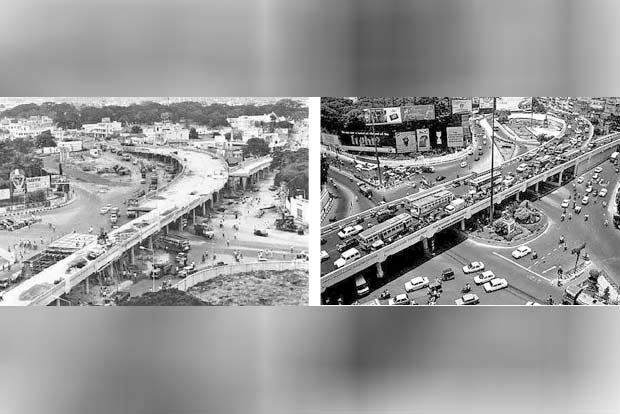Begin typing your search...
Those Were The Days: Flying over Mount Road that was Europeans’ cart track
In this series, we take a trip down memory lane, back to the Madras of the 1900s, as we unravel tales and secrets of the city through its most iconic personalities and episodes.

Chennai
It is the oldest road in Madras, a 400-year-old cart track used by the Europeans to travel from Fort St George to the holy mount of St Thomas. Over the decades and centuries, as the city grew in size and stature, the road, too, became more significant.
It was the main artery of the bustling city, and had all the attendant troubles – the traffic was a mess at every intersection, the most crowded being the Gemini Circle. In the 1970s, nearly 10,000 vehicles used to cross the junction during the peak hour.
The circle has a history of its own. Back in 1940, Gemini Studio opened here, becoming such an integral landmark that even the visiting premier of China wanted to pay a visit.
At one point of time, it housed two circuses where a dozen elephants used to be brought from harbour, walking all the way from there, to perform. But about 35 years later, the movie mogul SS Vasan was gone, and his heirs were in the process of closing down the studio.
Meanwhile, in November 1969, the then DMK government renamed Mount Road after the untimely death of chief minister and party founder CN Annadurai. It thus became Anna Salai.
The traffic on this busy thoroughfare was always hindered by the signal at Gemini Circle. The government turned to experts, seeking suggestions to ease traffic flow at this important junction.
The architects suggested a plan that was rather audacious for those times – a grade separator with two arms, each half a km long, to allow vehicles to fly over in four lanes.
It was a time when bridges were built only over rivers. There were only two plans to build flyovers, both in cash-rich Bombay. The first one, the Kemps Corner flyover, that was constructed between two hills that had opened a few years earlier. But the one proposed on Anna Salai was longer.
The government approved the plan with Rs 70 lakh outlay. As the construction work narrowed and further clogged the road, the company, East Coast Construction, was allotted only two years to complete the work.
To their credit, the construction went on at such a hectic pace that the flyover was built in less than the allotted two years.
On July 1, 1973, the flyover was opened to traffic. The opening was cinematic – police vehicles with beacons on led the way for the other vehicles. As was expected, the then chief minister M Karunanidhi named the flyover after Anna at a public function.
In the months after it was opened, tourists thronged the area to see the vehicles ‘flying over’ – the parapet walls hid their wheels, giving that impression to those standing on the road below.
Almost every Tamil film in the subsequent years had a duet or fight sequence that had this novelty as the backdrop, making the flyover a well-recognised landmark of Madras.
Under the highest point of the flyover was a garden on two semi circles. A year after the flyover opened, the government deemed betting on horses illegal because it was ruining families.
In those gardens, two identical statues of a man reining a horse were installed to commemorate the decision. The High Court later struck down the order, but the statues remained there on either side of the overpass.
In 1998, terrorists made an unsuccessful bid to blow up the flyover with a bomb. There is speculation that the intended target was the American Consulate situated nearby. The bridge withstood the explosion.
One of the rare accidents that happened on the flyover was in 2012 when a government bus overturned and fell from a height of 20 feet while negotiating a bend.
The vehicle was dangling over the edge after crashing into the parapet before falling down headlong. Forty passengers were injured in the incident, and the driver was summarily dismissed.
When it was opened five decades ago, more than 9,000 vehicles crossed the junction during peak hours. This number has grown manifold in the intervening years, but as a credit to the designers that there has not been any change in its structure or flow of traffic in these years.
The city still fondly remembers the studio that was such an integral part of the city but vanished around the same time that this flyover was built.
With the name Gemini firmly stuck to their minds, they continued to call the area Gemini Circle and Gemini flyover.
Today, Chennai is a city of flyovers; it all started with this overpass on Anna Salai that was nothing short of an engineering marvel during those times.
—The author is a historian
Visit news.dtnext.in to explore our interactive epaper!
Download the DT Next app for more exciting features!
Click here for iOS
Click here for Android
Next Story



